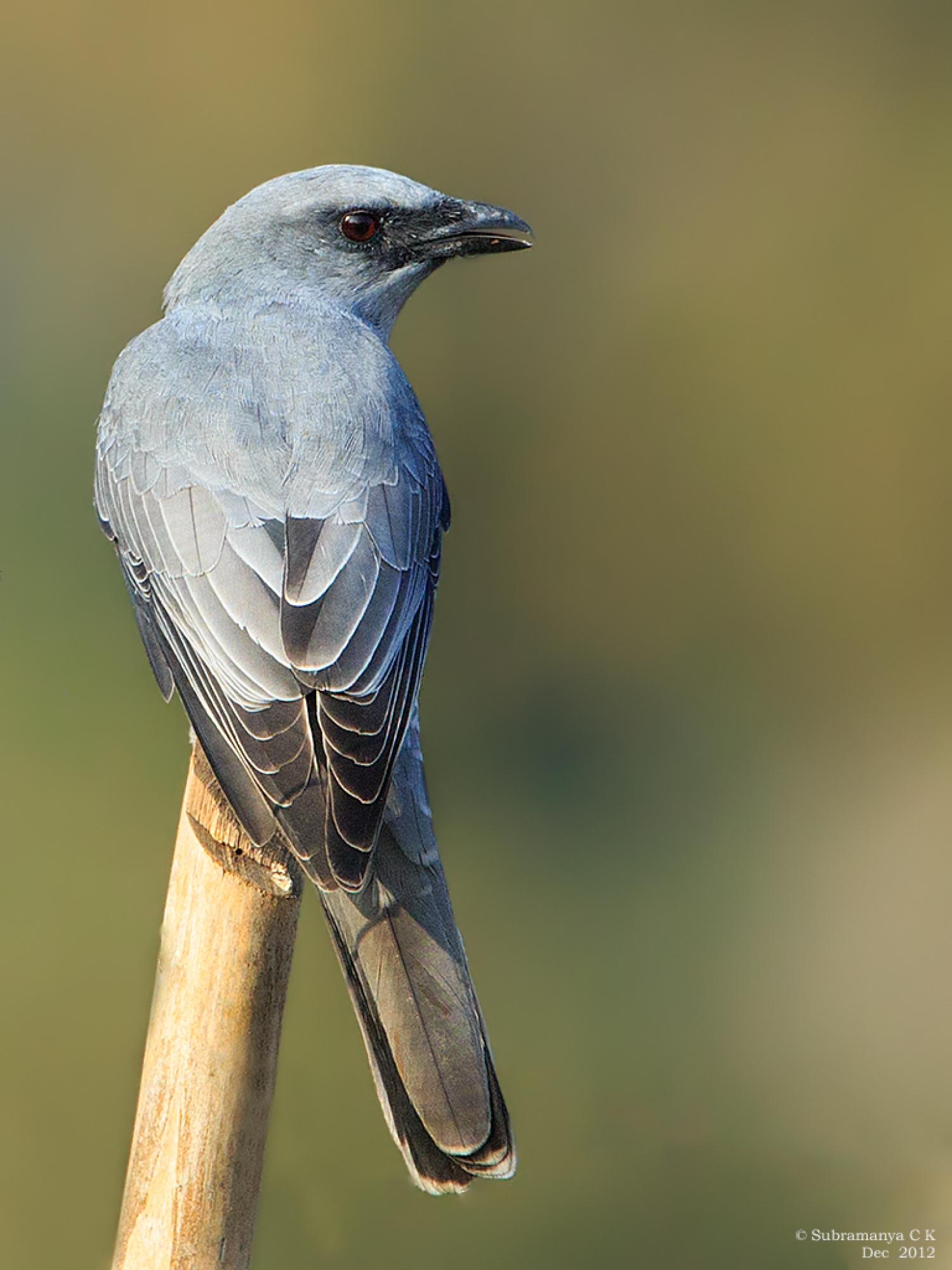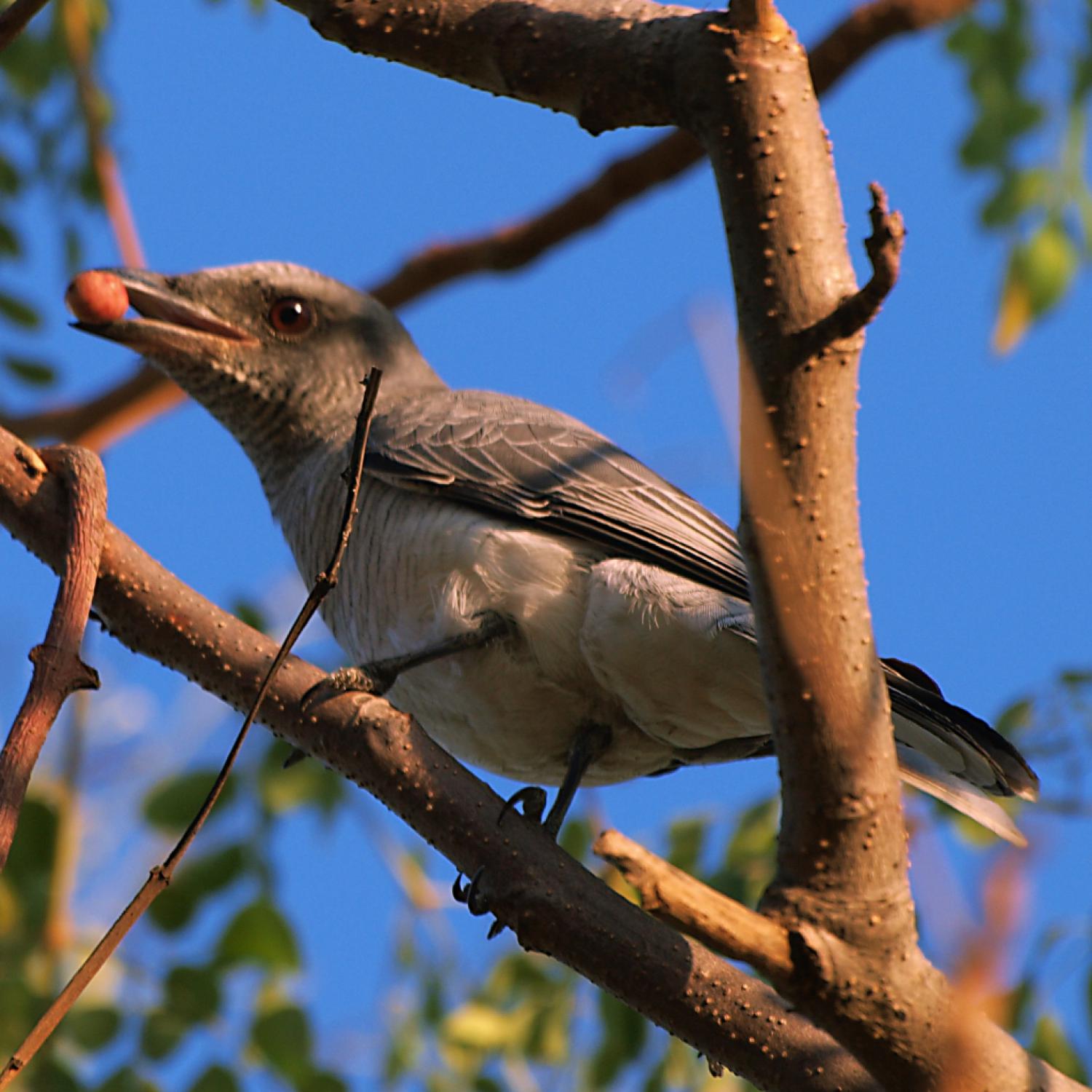Species of Thailand
Large cuckooshrike
Coracina macei
René-Primevère Lesson, 1830
In Thai: นกขี้เถ้าใหญ่
The large cuckooshrike (Coracina macei) is a species of cuckooshrike found in the Indian Subcontinent and depending on the taxonomic treatment used, Southeast Asia. The species has had a long and varied taxonomic treatment, being closely related to forms across Southeast Asia, with some authors using the name Indian cuckooshrike (which then refers only to the species that includes the forms C. m. macei of peninsular India and C. m. layardi of Sri Lanka). The species and subspecies classifications vary widely across sources and are yet to be resolved unambiguously.
Description
Adult males have a broad and well-marked eye stripe which is pale in females. The throat and breast are grey in males and the abdomen and flanks are finely barred. Females have the throat and breast also with barring which extends further down and lacks the prominent whitish vent of the male. They are mostly insectivorous but also feed on figs and forest fruits and usually fly in small groups with a bounding flight just above the forest canopy. The Indian population has a loud call klu-eep and the birds have a characteristic habit of flicking their closed wings one after the other upon landing on a perch. The same wing movements are also used during courtship.
Taxonomy and systematics
Several subspecies are recognized but there is considerable confusion and the taxonomy of the group is not fully resolved. The IOC classification considers the following subspecies within the species macei:
- C. m. nipalensis (Hodgson, 1836) of the Himalayas (some authors treat this as a subspecies of C. javensis)
- C. m. macei (Lesson, R, 1831) of peninsular India
- C. m. layardi (Blyth, 1866) of Sri Lanka
- C. m. andamana (Neumann, 1915) of the Andaman Islands
- C. m. rexpineti (Swinhoe, 1863) of southeastern China, Taiwan, Laos and Vietnam
- C. m. larvivora (Hartert, 1910) of Hainan (off China)
- C. m. siamensis (Baker, ECS, 1918) of Myanmar and southern China to southern Indochina
- C. m. larutensis (Sharpe, 1887) of the Malay Peninsula (some authors treat this as a subspecies of C. javensis or as a separate species)
The species was for sometime lumped, treated as a subspecies of Coracina novaehollandiae within the caledonica superspecies.
Breeding
The species breeds in the dry months of winter. The nest is a shallow saucer placed in the fork of a horizontal branch at some height above the ground. The saucer is made of twigs and grass decorated on the outside with cobwebs and with little lining. The typical clutch is three eggs in peninsular India and two around Bengal.
This article uses material from Wikipedia released under the Creative Commons Attribution-Share-Alike Licence 3.0. Eventual photos shown in this page may or may not be from Wikipedia, please see the license details for photos in photo by-lines.
Category / Seasonal Status
BCST Category: Recorded in an apparently wild state within the last 50 years
BCST Seasonal status: Resident or presumed resident
Scientific classification
- Kingdom
- Animalia
- Phylum
- Chordata
- Class
- Aves
- Order
- Passeriformes
- Family
- Campephagidae
- Genus
- Coracina
- Species
- Coracina macei
Common names
- Thai: นกขี้เถ้าใหญ่
Synonyms
- Graucalus macei, René-Primevère Lesson (1831)
Conservation status

Least Concern (IUCN3.1)
Photos
Please help us review the bird photos if wrong ones are used. We can be reached via our contact us page.
Range Map

- Chiang Dao Wildlife Sanctuary
- Doi Chong National Park
- Doi Inthanon National Park
- Doi Lang
- Doi Lo District, Chiang Mai
- Doi Pha Hom Pok National Park
- Hala-Bala Wildlife Sanctuary
- Huai Kha Khaeng Wildlife Sanctuary
- Kaeng Krachan National Park
- Khao Khitchakut National Park
- Khao Soi Dao Wildlife Sanctuary
- Khao Yai National Park
- Khon San District, Chaiyaphum
- Khun Chae National Park
- Mae Ping National Park
- Mae Sot District, Tak
- Mae Wong National Park
- Mueang Nakhon Nayok District, Nakhon Nayok
- Mueang Nonthaburi District, Nonthaburi
- Mueang Tak District, Tak
- Nam Nao National Park
- Omkoi Wildlife Sanctuary
- Pa Sang District, Lamphun
- Pachee River Wildlife Sanctuary
- Pha Daeng National Park
- Phu Hin Rong Kla National Park
- Phu Khiao Wildlife Sanctuary
- Phu Kradueng National Park
- Phu Langka National Park
- Phu Luang Wildlife Sanctuary
- Phu Soi Dao National Park
- Phu Suan Sai National Park
- Sai Yok District, Kanchanaburi
- Sakaerat Environmental Research Station
- Sri Nakarin Dam National Park
- Tha Yang District, Phetchaburi
- Thap Lan National Park
- Thung Yai Naresuan Wildlife Sanctuary

